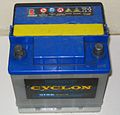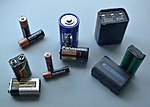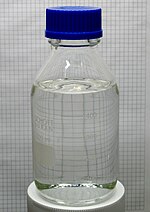The lead–acid battery is a type of rechargeable battery first invented in 1859 by French physicist Gaston Planté. It is the first type of rechargeable...
58 KB (7,556 words) - 12:03, 22 November 2024
A valve regulated lead–acid (VRLA) battery, commonly known as a sealed lead–acid (SLA) battery, is a type of lead–acid battery characterized by a limited...
25 KB (3,219 words) - 21:32, 15 November 2024
Most types of batteries can be recycled. However, some batteries are recycled more readily than others, such as lead–acid automotive batteries (nearly 90%...
53 KB (5,305 words) - 22:51, 11 November 2024
regulator to keep the output between 13.5 and 14.5 V. Modern SLI batteries are lead-acid type, using six series-connected cells to provide a nominal 12-volt...
27 KB (3,186 words) - 12:39, 10 November 2024
applications in electrochemistry, in particular as the positive plate of lead acid batteries. Lead dioxide has two major polymorphs, alpha and beta, which occur...
14 KB (1,458 words) - 06:20, 27 September 2024
consumed, they cannot be electrically recharged. The development of the lead-acid battery and subsequent "secondary" or "chargeable" types allowed energy to...
37 KB (4,666 words) - 00:05, 22 November 2024
28 Johnson Controls Optima Yellow Top spiral wound AGM deep cycle lead–acid batteries in series, which produced 150 & 165 kW (220 horsepower) and 177 lbs·ft...
14 KB (1,738 words) - 12:49, 7 September 2024
deep-cycle battery is a battery designed to be regularly deeply discharged using most of its capacity. The term is traditionally mainly used for lead–acid batteries...
9 KB (1,022 words) - 08:41, 16 November 2024
increased to about half of that of primary batteries, and significantly greater than lead–acid batteries. Jungner experimented with substituting iron...
34 KB (4,829 words) - 01:24, 6 October 2024
electrochemical reaction, as in lead–acid cells. The energy used to charge rechargeable batteries usually comes from a battery charger using AC mains electricity...
48 KB (5,080 words) - 21:21, 3 November 2024
6-cell lead–acid battery arises purely from relativistic effects, explaining why tin–acid batteries do not work. In Tl(I) (thallium), Pb(II) (lead), and...
21 KB (2,637 words) - 06:00, 9 November 2024
world's largest producers, distributors and recyclers of lead-acid batteries. Lead-acid batteries are used in automobiles, golf carts, fork-lifts, electric...
75 KB (8,209 words) - 02:23, 15 August 2024
include the lead–acid batteries used in vehicles and lithium-ion batteries used for portable electronics such as laptops and mobile phones. Batteries come in...
70 KB (7,449 words) - 15:33, 2 November 2024
domestic acidic drain cleaners, as an electrolyte in lead-acid batteries, as a dehydrating compound, and in various cleaning agents. Sulfuric acid can be...
64 KB (7,136 words) - 17:57, 1 November 2024
Inverter battery Lantern battery Nanobatteries Nanowire battery Local battery Polapulse battery Photoflash battery Reserve battery Smart battery system...
6 KB (203 words) - 14:28, 4 November 2024
Exide (redirect from Electric Battery Storage Company)
Technologies, an American lead-acid batteries manufacturing company. Exide Holdings manufactured automotive batteries and industrial batteries. Exide Holdings is...
44 KB (3,965 words) - 01:42, 14 November 2024
lead has been used as a coolant for lead-cooled fast reactors. The largest use of lead in the early 21st century is in lead–acid batteries. The lead in...
178 KB (19,217 words) - 09:44, 2 November 2024
General Motors EV1 (section Drivetrain and battery)
later refined by Hughes Electronics. The car was powered by 32 lead–acid rechargeable batteries. On April 18, 1990 Smith announced that the Impact would become...
85 KB (8,048 words) - 02:30, 20 November 2024
UltraBattery is a trademark of the lead-acid battery technology commercialized by Furukawa Battery Co. Ltd. UltraBattery has thin carbon layers on spongy...
37 KB (4,849 words) - 10:03, 9 October 2024
explode. For example, an automobile SLI (starting, lighting, ignition) lead–acid battery carries several risks of explosion. A newer type of charger is known...
33 KB (4,124 words) - 17:46, 8 November 2024
Trickle charging (category Battery charging)
the lead–acid battery splitting the water in the electrolyte into hydrogen and oxygen gases. Other battery chemistries, such as lithium-ion battery technology...
3 KB (372 words) - 17:47, 10 October 2024
established rechargeable battery technologies in the market currently: the lithium-ion battery and the rechargeable lead–acid battery. Companies around the...
69 KB (7,043 words) - 18:54, 18 November 2024
lasting only seconds. Battery rooms were used to segregate the fumes and corrosive chemicals of wet cell batteries (often lead–acid) from the operating...
7 KB (903 words) - 05:49, 8 July 2024
Jump start (vehicle) (redirect from Automotive battery booster)
boost the dead vehicle battery. Jump starters using lead-acid batteries claim 300−1700 amp ratings. The main disadvantage of lead-acid jump starters is weight...
14 KB (1,796 words) - 04:53, 30 September 2024
A battery regenerator is a device that restores capacity to lead-acid batteries, extending their effective lifespan. They are also known as desulphators...
7 KB (923 words) - 17:41, 10 October 2024
Jelly roll Lead–acid battery List of battery sizes List of battery types Lithium-ion battery Lithium iron phosphate battery Nickel–zinc battery Nickel(II)...
37 KB (3,993 words) - 03:50, 18 November 2024
paste for lead–acid batteries. A related mineral is leadhillite, 2PbCO3·PbSO4·Pb(OH)2. At high concentration of sulfuric acid (>80%), lead hydrogensulfate...
10 KB (671 words) - 15:12, 9 April 2024
Silver–calcium alloy batteries are a type of lead–acid battery with grids made from lead–calcium–silver alloy, instead of the traditional lead–antimony alloy...
2 KB (216 words) - 18:07, 18 November 2023
Electrochemical cell (redirect from Battery cell)
primary battery in high end products. A secondary cell produces current by reversible chemical reactions (ex. lead-acid battery car battery) and is rechargeable...
18 KB (2,133 words) - 03:34, 16 November 2024
Uninterruptible power supply (redirect from Battery backup)
types of UPS batteries: Valve Regulated Lead Acid (VRLA), Flooded Cell or VLA batteries, and lithium-ion batteries. The run-time for a battery-operated UPS...
49 KB (6,139 words) - 02:47, 23 October 2024


























